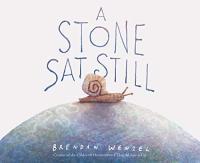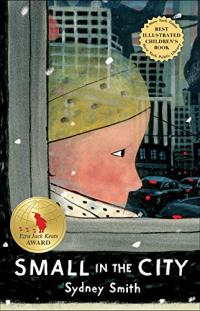
When Uncle and Windy Girl and Itchy Boy attend a powwow, Windy watches the dancers in their jingle dresses and listens to the singers. She eats tasty food and joins family and friends around the campfire. Later, Windy falls asleep under the stars. Now Uncle’s stories inspire other visions in her head: a bowwow powwow, where all the dancers are dogs. This playful story is accompanied by a companion retelling in Ojibwe.
Bowwow Powwow

To the Gitxsan people of northwestern British Columbia, the grizzly is an integral part of the natural landscape. They share the land and forests the Skeena River runs through, as well as the sockeye salmon within it. The Grizzly Mother explores how an ecosystem’s animals, people, and seasons are all intertwined.
The Grizzly Mother

Bilingual in English and Cree, this story of the far north follows a family of four that has a spiritual connection to the caribou of the land. One brother, Joe, plays the accordion (a kitoochigan) and sings while the other, Cody, dances. On a magical day, all of nature aligns and ten thousand caribou come when the boys call. Though the stampede is strong, Cody and Joe emerge from the experience unharmed.
Caribou Song

They communicate, play, use tools, and sometimes even fight. Find out how different animals behave in this well-organized, engaging, and educational look at animal behavior. Illustrations complement the accessible text on each double-page spread. A glossary and additional resources are included.
Surprising Lives of Animals: How They Can Laugh, Play and Misbehave!

He’s small, a bit rough around the edges but he’s got a big heart and big friends. Meet Bob of dubious heritage; “…some Chihuahua, with a smidgen of Papillon…” His best friends are a gorilla named Ivan, a small elephant named Ruby, and a girl named Julia. The sequel to the Newbery-winning book, The One and Only Ivan (opens in a new window), this new story can stand alone with its unique verve and charm. Spot illustrations and a glossary of dog terms add humor and emotion.
The One and Only Bob

There are two sides to everything, including animals. Creatures like black cats, vampire bats, Tasmanian devils, and a host of other animals often have bad reputations — but there is another side! Explore both in an an open format with humorous illustrations. A glossary is included.
The Not Bad Animals

Can rescue dog, McTavish, help his Peachy family with vacation plans? His human family needs his guidance and patience — again. Whether revisiting the Peachys (Good Dog, McTavish (opens in a new window)) or meeting them for the first time, this charming, recognizable family is sure to charm readers of all ages.
McTavish Goes Wild

Readers know from the title page that the dog will not give up the spotlight. The dog is really a scruffy mutt who creates chaos and lots laughter as it peeks onto pages with other animals. Expressive animals appear on uncluttered colored backgrounds until the surprise conclusion.
This Is a Dog

Very Big Crab reassures Little Crab when they leave their tiny tidal pool for the large sea. Few details are needed as illustrations swirl expressively across pages as the pair makes their way to the joys that they find in the ocean.
Don’t Worry, Little Crab

Everyone has seen a housefly and many other familiar insects in this collection of short, lighthearted poems. Illustrations are humorous, adding verve and humor to the poems.
Common Critters: The Wildlife in Your Neighborhood

A small white dog and his human dad move in with a cat and a large dog and their human mom. Though the transition is tough, they make it — until a “Waaah!” joins the family. Understated, comical, and relatable, this experience is presented with expressive illustration and limited language.
Cat Dog Dog: The Story of a Blended Family

A red crab hides in order to surprise the blue fish, green sea turtle, and other colorful unsuspecting sea creatures until something bigger comes along. The rhyming text and bright illustrations are sure to inform and delight young readers.
Snap: A Happy Book of Colors

Animals can be found in forests, under the sea, and even on a safari. But in this sturdy book, one has to lift a flap — maybe two — to find them.
My Peekaboo Animals

Can you find the monkey hiding in the grocery store? Join shoppers as they find and hide the small animal in this sturdy, interactive jaunt to the store.
I Thought I Saw a Monkey!

Lush, textured illustrations introduce animals on tall, sturdy pages. When flaps are opened, the illustrations expand and a bit of factual information is presented for a unique way to present fascinating creatures. Also by Jenkins: Sea Creatures Swim (opens in a new window).
Dinosaurs Roar

Suddenly “awake” in the middle of winter, a “big bear” explores a “cozy cabin,” which Bear of course “enters excitedly.” But the cabin isn’t empty — a little girl lives there. So begins an unlikely friendship and an unexpected adventure as the girl attempts to figure out what a bear is supposed to be doing in the winter. (Hint: It’s not eating pancakes or visiting the library!)
Bear Is Awake! An Alphabet Story

Former children’s poet laureate, J. Patrick Lewis, allows the polar bear tell us what he’s called in different cultures — White Bear, Ice Bear, Sea Bear, Sailor of the Icebergs, the Ever-wandering One. The Inuit’s say “I am Nanuk”). The devastating ending shows the polar bear adrift on a shrinking bit of ice, “losing hold” — a reference to how this Arctic animal is threatened by extinction and in need of human protection.
I Am Polar Bear

Look! A line of paw prints in the snow. Follow the tracks to see the rare and majestic snow leopard and visit her secret world. Join a zoologist in the Himalayan mountains as he searches for the elusive creature. With her pale gold and silver-gray coat painted with black rosettes, she blends so well into the boulders, it’s no wonder she’s thought of as a ghost of the mountains. Written by a zoologist and interwoven with fascinating facts, this look at a fascinating animal includes an end note suggesting resources to explore.
Snow Leopard: Ghost of the Mountains

How do we know something that is invisible is really all around? With our noses! Human “noses can detect more than 400,000 different smells.” Animals use their noses for different reasons; dogs smell marked territory, great white sharks detect prey. Sometimes humorous illustrations and flaps that lift reveal a bundle of information sure to inspire further inquiry.
Nose Knows: Wild Ways Animals Smell the World

There is great drama to be found on the Serengeti witnessed by scientists. Meet some of those who study the migration of wildebeest in Tanzania. Observe the animals that share the land with the wildebeest. The author’s insightful, illuminating, and highly readable narration in a handsome format with stunning photographs is also a plea for humankind to respect other mammals.
The Magnificent Migration: On Safari with Africa’s Last Great Herds

From farming to feelings, from teamwork to community, “…it turns out that the respect for animals that is so important in indigenous traditions makes very good sense.” In other words, humans and animals share a great deal, making all creatures “humanimals” — a case presented in clear illustration and straightforward text. The scientists who study animals and their behavior are included, as are additional resources.
Humanimal: Incredible Ways Animals Are Just Like Us

Never heard of the black and rufous sengi? How about Brainville’s beaked whale? Lions, and tigers and giraffes are all familiar, but in this humorously illustrated and informative volume you’ll find out about even more less-well-known animals. As in the first book in the series, Lesser Spotted Animals (opens in a new window), readers meet unfamiliar animals, where they are found, what they eat, and if they are thriving. After all, “how can we help something survive if we don’t even know it exists?”
Even More Lesser Spotted Animals

How can one thing be smooth and rough, a feel and a smell, and red, green, and purple, too? Does the stone that “sat still…as it was where it was in the world” change or is it how different animals see it? Poetic language and softly lined and colored illustration combine to present a book about change and constancy, sure to generate discussion.
A Stone Sat Still

A child travels alone on a bus through a bustling city. Who is the narrator addressing? Is the reader or someone else? The child offers advice, like “Alleys can be good shortcuts…” but there are dangers, too. Arriving home to a red door and a warm embrace, the child confidently says “You will be all right.” Only close examination of the stunning illustrations provides clues as to who (or what) is really small and alone in the city.
